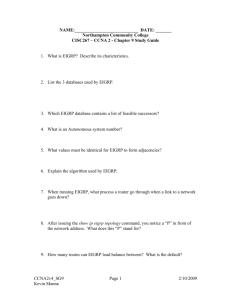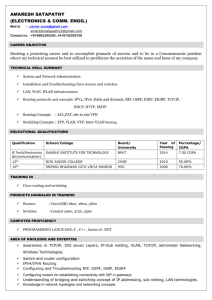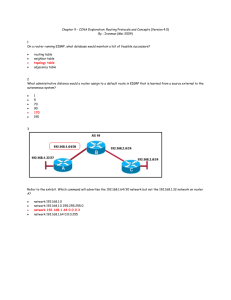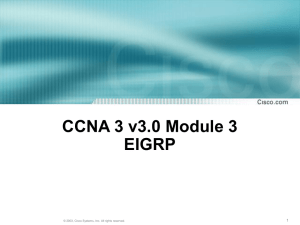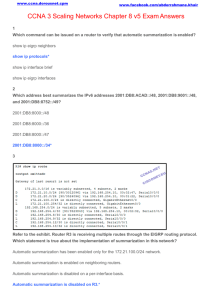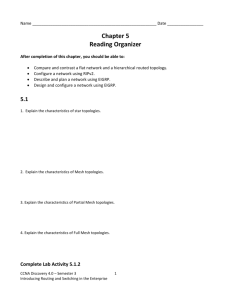EIGRP
advertisement
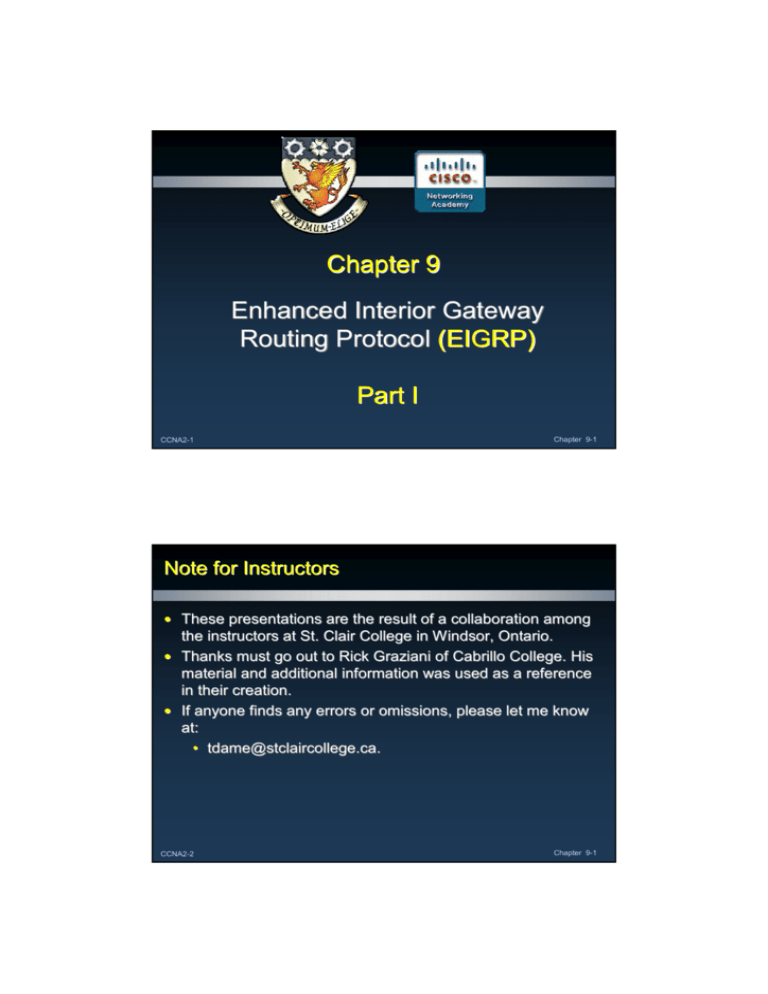
Chapter 9 Enhanced Interior Gateway Routing Protocol (EIGRP) Part I CCNA2-1 Chapter 9-1 Note for Instructors • These presentations are the result of a collaboration among the instructors at St. Clair College in Windsor, Ontario. • Thanks must go out to Rick Graziani of Cabrillo College. His material and additional information was used as a reference in their creation. • If anyone finds any errors or omissions, please let me know at: • tdame@stclaircollege.ca. CCNA2-2 Chapter 9-1 EIGRP Introduction to EIGRP Chapter 9-1 CCNA2-3 Roots of EIGRP • Enhanced Interior Gateway Routing Protocol (EIGRP) is a Distance Vector, Classless routing protocol. • Released in 1992 with Cisco IOS Software Release 9.21. • Enhancement of Cisco’ Cisco’s Interior Gateway Routing Protocol (IGRP). • Both are Cisco proprietary protocols and operate only on Cisco routers. Chapter 9-1 CCNA2-4 Roots of EIGRP • Cisco’ Cisco’s Interior Gateway Routing Protocol (IGRP) has been discontinued and is no longer supported by Cisco. Chapter 9-1 CCNA2-5 Roots of EIGRP CCNA2-6 Chapter 9-1 EIGRP Message Format Data Link Frame Header Data IP Packet Header EIGRP Packet Header FCS Type/Length/Values (TLV) • The EIGRP frame is encapsulated just like any other frame on an Ethernet network. • Like any other protocol, the content of the fields themselves is important to the proper functioning of EIGRP. Chapter 9-1 CCNA2-7 EIGRP Message Format Data Link Frame Header IP Packet header EIGRP Packet header Type/Length/Values (TLV) • Data Link Frame Header: • Source MAC Address: • The MAC address of the sending interface. • Destination MAC Address: • The multicast address 1010-0000-0505-0000-0000-0A. 0A. • Unlike a RIP broadcast, EIGRP multicasts its frames using a specific multicast address. Only those hosts on the network (other routers) listening on that address will accept the frame. CCNA2-8 Chapter 9-1 EIGRP Message Format Data Link Frame Header IP Packet header EIGRP Packet header Type/Length/Values (TLV) • IP Packet Header: • Source IP Address: • The IP Address of the sending interface. • Destination IP Address: • The multicast address 224.0.0.10. 224.0.0.10. • Protocol Field: • 88 for EIGRP. Chapter 9-1 CCNA2-9 EIGRP Message Format Data Link Frame Header CCNA2-10 IP Packet header EIGRP Packet header Type/Length/Values (TLV) Chapter 9-1 EIGRP Message Format Data Link Frame Header IP Packet header EIGRP Packet header Type/Length/Values (TLV) • EIGRP Packet Header: • Opcode: • Specifies the type of EIGRP packet. • Update, Query, Reply, Hello • Autonomous System Number: • Specifies the EIGRP routing process. Unlike RIP, routers using EIGRP can have multiple instances of EIGRP running concurrently. Chapter 9-1 CCNA2-11 EIGRP Message Format Data Link Frame Header IP Packet header EIGRP Packet header Type/Length/Values (TLV) • The Type/Length/Values (TLV) field is used to convey different EIGRP information and/or parameters. • Each is distinguished by a specific 4 byte hexadecimal type code. • We will be discussing: • Type 0x0001 – EIGRP Parameters • Type 0x0002 – IP Internal Routes • Type 0x0003 – IP External Routes CCNA2-12 Chapter 9-1 EIGRP Message Format Data Link Frame Header IP Packet header EIGRP Packet header Type/Length/Values (TLV) • Type 0x0001 – EIGRP Parameters: • Contains information regarding the metric and the hold time for the route to the receiving neighbour. Chapter 9-1 CCNA2-13 EIGRP Message Format • RIP uses hop count to provide the metric used to determine the best path to a destination. • EIGRP weighs bandwidth, delay, reliability and load to produce a composite metric value. • These weights are included in the “K” value fields. • K1 (Bandwidth) and K3 (Delay) default to 1. • Others default to 0. CCNA2-14 Chapter 9-1 EIGRP Message Format • Hold Time: • The amount of time that the EIGRP router receiving this message should wait in between messages. • If this timer expires before another EIGRP message is received, the receiving router will consider the sending router to be down. Chapter 9-1 CCNA2-15 EIGRP Message Format Data Link Frame Header IP Packet header EIGRP Packet header Type/Length/Values (TLV) • Type 0x0002 – IP Internal Routes: • This message is used to advertise EIGRP routes within an Autonomous System. System. CCNA2-16 Chapter 9-1 EIGRP Message Format • We will be concerned with: • The metric fields Delay and Bandwidth. • Prefix Length. • Destination. Chapter 9-1 CCNA2-17 EIGRP Message Format • Delay and Bandwidth: • Delay is calculated as the sum of delays from source to destination in units of 10 microseconds. • Bandwidth is the lowest configured bandwidth of any interface along the route. CCNA2-18 Chapter 9-1 EIGRP Message Format • Prefix Length: • Essentially, the subnet mask. • Subnet mask of 255.255.255.0 has a prefix length of 24. Chapter 9-1 CCNA2-19 EIGRP Message Format • Destination: • The destination network. • Because the minimum length of this field is 24 bits, the remainder of the field is padded with 0s. • If a network address is longer than 24 bits (192.168.1.32/27), the field is extended for another 32 bits and the unused bits are padded with 0s. Chapter 9-1 CCNA2-20 EIGRP Message Format Data Link Frame Header IP Packet header EIGRP Packet header Type/Length/Values (TLV) • Type 0x0003 – IP External Routes • Routes received from outside the AS. Chapter 9-1 CCNA2-21 EIGRP Message Format • Note on MTU: • Some EIGRP literature might incorrectly state that the maximum transmission unit (MTU) is one of the metrics used by EIGRP. • While it is included in the routing update, the MTU is not part of the metric used by EIGRP. CCNA2-22 Chapter 9-1 Protocol-Dependant Modules • ProtocolProtocol-Dependant Modules are responsible for the specific routing tasks for each network layer protocol. Chapter 9-1 CCNA2-23 Protocol-Dependant Modules • Each PDM keeps route and topology information readily available in RAM so it can react quickly to changes. • It saves this information in three tables. • Neighbour Table • Topology Table • Routing Table CCNA2-24 Chapter 9-1 Protocol-Dependant Modules • Neighbor Table: • Lists all adjacent or neighbour routers. • Topology Table: • Includes route entries for all destinations that the router has learned. • Routing Table: • EIGRP chooses the best routes to a destination from the topology table and places these routes in the routing table. Chapter 9-1 CCNA2-25 Protocol-Dependant Modules • Neighbor Table: • When newly discovered neighbours are learned, the address and interface of the neighbour is recorded. • When a neighbour sends a hello packet, it advertises a hold time. • When the hold time expires, the link is considered unavailable and the new topology must be recalculated. CCNA2-26 Chapter 9-1 Protocol-Dependant Modules • Topology Table: • The topology table is made up of all the EIGRP routing tables in the autonomous system. • DUAL uses the information in the neighbour and topology tables to calculate the lowest cost routes to each destination. • All learned routes to a destination are maintained in the topology table. Chapter 9-1 CCNA2-27 RTP and EIGRP Packet Types • Reliable Transport Protocol (RTP) is the protocol used by EIGRP for the delivery and reception of EIGRP packets. • RTP includes both reliable delivery and unreliable delivery of EIGRP packets, similar to TCP and UDP. CCNA2-28 Chapter 9-1 RTP and EIGRP Packet Types Hello Packet Chapter 9-1 CCNA2-29 RTP and EIGRP Packet Types Update and Acknowledgment Packets CCNA2-30 Chapter 9-1 RTP and EIGRP Packet Types Query and Reply Packets Chapter 9-1 CCNA2-31 Hello Protocol Most Networks • Before any EIGRP packets can be exchanged between routers, EIGRP must first discover its neighbors. • EIGRP routers discover neighbors and establish adjacencies with neighbor routers using the hello packet. • Hold Time: • An EIGRP router assumes that as long as it is receiving hello packets from a neighbor, the neighbor and its routes remain viable. CCNA2-32 Chapter 9-1 EIGRP Bounded Updates • EIGRP uses the terms partial and bounded when referring to its update packets. • EIGRP sends its updates only when the metric for a route changes. changes. • Partial: • The update only includes information about the route changes instead of sending the entire contents of the routing table. Chapter 9-1 CCNA2-33 EIGRP Bounded Updates • EIGRP uses the terms partial and bounded when referring to its update packets. • EIGRP sends its updates only when the metric for a route changes. changes. • Bounded: • Refers to the propagation of partial updates sent only to those routers that are affected by the change. CCNA2-34 Chapter 9-1 DUAL: An Introduction • Diffusing Update Algorithm (DUAL) is the convergence algorithm used by EIGRP. • Routing loops can be extremely detrimental to network performance. • Distance vector routing protocols such as RIP prevent routing loops with holdhold-down timers and split horizon. • Although EIGRP uses both of these techniques, it uses them somewhat differently. • The primary way that EIGRP prevents routing loops is with the DUAL algorithm. Chapter 9-1 CCNA2-35 Administrative Distance • When compared to other interior gateway protocols, EIGRP is the most preferred by the Cisco IOS software because it has the lowest AD. CCNA2-36 Chapter 9-1 Authentication • Like other routing protocols, EIGRP can be configured for authentication. • Authentication ensures that routers will only accept routing information from other routers that have been configured with the same password or authentication information. • The router authenticates the source of each routing update packet that it receives. • Authentication itself does not encrypt the router’ router’s routing table. table. Chapter 9-1 CCNA2-37 EIGRP Basic EIGRP Configuration CCNA2-38 Chapter 9-1 Autonomous System • Concept of Autonomous Systems (AS): (AS): A network or group of networks identified and administered as a single entity. Chapter 9-1 CCNA2-39 Autonomous System • An autonomous system is a collection of networks under the administrative control of a single entity that presents a common routing policy to the Internet. • Autonomous system numbers are assigned by the Internet Assigned Numbers Authority (IANA). • Who needs an Autonomous System number? • Internet Service Providers (ISPs), Internet Backbone Providers, and large institutions connecting to other entities that also have an autonomous system number.. Chapter 9-1 CCNA2-40 Process ID • Although EIGRP refers to the parameter as an “autonomousautonomous-system” system” number, it actually functions as a Process ID. ID. • The autonomous system parameter is a number chosen by the network administrator between 1 and 65,535. Chapter 9-1 CCNA2-41 The router eigrp Command • The Global configuration mode router eigrp command enables EIGRP. • All routers in an EIGRP routing domain must use the same process ID number (autonomous system number). CCNA2-42 Chapter 9-1 The network Command • The network command in EIGRP has the same function as in other IGP routing protocols: • Any interface on this router that matches the network address in the network command will be enabled to send and receive EIGRP updates. updates. • This network (or subnet) will be included in EIGRP routing updates. updates. Chapter 9-1 CCNA2-43 The network Command • The networknetwork-address is the classful network address for this interface. • A single classful network statement is used on R1 to include both 172.16.1.0/24 and 172.16.3.0/30 subnets. CCNA2-44 Chapter 9-1 The network Command • If you enter the individual network numbers for the interfaces, the Cisco IOS software will automatically convert them to a single, summarized network. Chapter 9-1 CCNA2-45 The network Command • When EIGRP is configured on R2, DUAL sends a notification message to the console stating that a neighbor relationship with another EIGRP router has been established. CCNA2-46 Chapter 9-1 The network Command • This new adjacency happens automatically because both R1 and R2 are using the same EIGRP 1 routing process and both routers are now sending updates on the 172.16.0.0 network. CCNA2-47 Chapter 9-1 The network Command with a Wildcard Mask • By default, when the network command and a classful network address such as 172.16.0.0 are used, all interfaces on the router that belong to that classful network address will be enabled for EIGRP. • There may be times when the network administrator does not want to include all interfaces within a network when enabling EIGRP. • To configure EIGRP to advertise specific subnets only, only, use the wildcardwildcard-mask option. CCNA2-48 Chapter 9-1 The network Command with a Wildcard Mask • Think of a wildcard mask as the inverse of a subnet mask. mask. • To calculate the inverse of the subnet mask, subtract the subnet mask from 255.255.255.255. CCNA2-49 Chapter 9-1 The network Command with a Wildcard Mask • Some Cisco IOS software versions also let you enter the subnet mask. • However, Cisco IOS software then converts the command to the wildcard mask format. format. CCNA2-50 Chapter 9-1 Network EIGRP Configuration Chapter 9-1 CCNA2-51 Verifying EIGRP • Verify adjacencies using show ip eigrp neighbors. neighbors. CCNA2-52 Chapter 9-1 Verifying EIGRP • Troubleshooting: • If a neighbor is not listed after adjacencies have been established with a router’ router’s neighbors, check that the local interface is activated using the show ip interface brief command. • If the interface is active, ping the IP address of the neighbor. • If the ping fails, it means that the neighbor interface is down and needs to be activated. Chapter 9-1 CCNA2-53 Verifying EIGRP • Troubleshooting: • If the ping is successful and EIGRP still does not see the router as a neighbor, examine the following configurations: • Are both routers configured with the same EIGRP process ID? • Is the directly connected network included in the EIGRP network statements? • Is the passivepassive-interface command inappropriately configured, thus preventing EIGRP hello packets on the interface? CCNA2-54 Chapter 9-1 Verifying EIGRP Chapter 9-1 CCNA2-55 Examining The Routing Table: R1 • Notice that EIGRP routes are denoted in the routing table with a D, which stands for DUAL. DUAL. CCNA2-56 Chapter 9-1 Examining The Routing Table: R2 • EIGRP is a classless routing protocol (includes the subnet mask in the routing update). • EIGRP supports variablevariable-length subnet masks (VLSM) and classless interinter-domain routing (CIDR). (CIDR). Chapter 9-1 CCNA2-57 Examining The Routing Table: R3 • By default, EIGRP automatically summarizes routes at the major network boundary. • You can disable the automatic summarization with the no autoauto-summary command, just as you did for RIPv2. CCNA2-58 Chapter 9-1 Introducing the Null0 Summary Route • The 192.168.10.0/24 and 172.16.0.0/16 routes do not actually represent a path to reach the parent networks. • If the packet matches the level 1 parent, but none of the child route subnets, subnets, the packet is discarded (sent to the Null0 interface). CCNA2-59 Chapter 9-1 Introducing the Null0 Summary Route • EIGRP automatically includes a Null0 summary route as a child route whenever both of the following conditions exist: • There is at least one subnet that was learned via EIGRP. • Automatic summarization is enabled. CCNA2-60 Chapter 9-1 R3 Routing Table • Because R3 is getting equal cost routes for 172.16.0.0/16 from R1 and R2, both are included in the routing table. • Both R1 and R2 are automatically summarizing the 172.16.0.0/16 network and sending it as a single routing update. Chapter 9-1 CCNA2-61 EIGRP EIGRP Metric Calculation CCNA2-62 Chapter 9-1 EIGRP Composite Metric and the K Values • EIGRP uses the following values in its composite metric to calculate the preferred path to a network: • Bandwidth • Delay • Reliability • Load Chapter 9-1 CCNA2-63 The Composite Metric Only bandwidth and delay are used for the default composite metric. • By default, K1 and K3 are set to 1, and K2, K4, and K5 are set to 0. CCNA2-64 Chapter 9-1 Verifying the Composite Metric • The K values on R1 are set to the default. • Changing these values to other than the default is not recommended unless the network administrator has a very good reason to do so. Chapter 9-1 CCNA2-65 Examining the Metric Values • The show interface command, lets you can examine the actual values used for bandwidth, delay, reliability, and load in the computation of the routing metric. CCNA2-66 Chapter 9-1 Examining the Metric Values • Bandwidth: • The bandwidth metric (1544 Kbps) is a static value used by protocols such as EIGRP and OSPF. • Displayed in kilobits per second (Kbps). (Kbps). • The value displayed might or might not reflect the actual physical bandwidth of the interface. Chapter 9-1 CCNA2-67 Examining the Metric Values • Bandwidth: • Modifying the bandwidth value does not change the actual bandwidth of the link. • If the actual bandwidth of the link differs from the default bandwidth value, you should modify the bandwidth value to ensure an accurate composite metric. CCNA2-68 Chapter 9-1 Examining the Metric Values • Delay: • Delay is a measure of the time it takes for a packet to traverse a route. • The delay (DLY) metric is a static value based on the type of link and is expressed in microseconds. • The router does not actually track how long packets are taking to reach the destination. Chapter 9-1 CCNA2-69 Examining the Metric Values • Reliability: • Reliability is a measure of the probability that the link will fail or how often the link has experienced errors. • Unlike delay, reliability is measured dynamically with a value between 0 and 255, with 1 being a minimally reliable link and 255 being 100 percent reliable. reliable. CCNA2-70 Chapter 9-1 Examining the Metric Values • Reliability: • Reliability is a measure of the probability that the link will fail or how often the link has experienced errors. • Reliability is expressed as a fraction of 255; 255; the higher the value, the more reliable the link. • 255/255 would be 100 percent reliable, reliable, whereas a link of 234/255 would be 91.8 percent reliable. reliable. Chapter 9-1 CCNA2-71 Examining the Metric Values • Load: • Load reflects the amount of traffic using the link. • Load is expressed as a fraction of 255. A lower load value is more desirable. desirable. • 1/255 would be a minimally loaded link. • 40/255 is a link at 16 percent capacity. • 255/255 is a link that is 100 percent saturated. CCNA2-72 Chapter 9-1 Using the bandwidth Command • On most serial links, the bandwidth metric defaults to 1544 Kbps. • Because both EIGRP and OSPF use bandwidth in default metric calculations, a correct value for bandwidth is very important to the accuracy of routing information • Use the interface command bandwidth to modify the bandwidth metric. • Use the interface command no bandwidth to restore the default value. Chapter 9-1 CCNA2-73 Using the bandwidth Command Default Bandwidth CCNA2-74 Chapter 9-1 Using the bandwidth Command • Verify the change using the show interface command. Chapter 9-1 CCNA2-75 Calculating the EIGRP Metric If you like using a calculator, this slide is for you! Just know that the composite metric appears here in the routing table entry. CCNA2-76 Chapter 9-1

